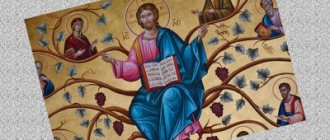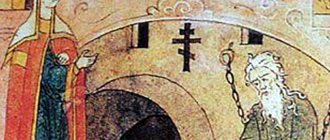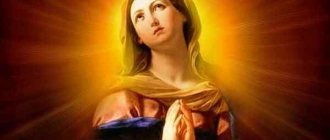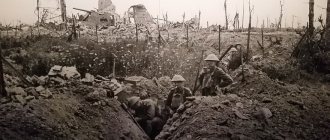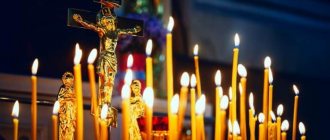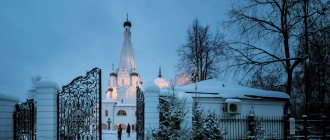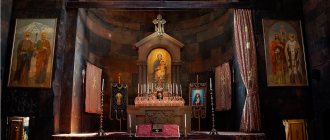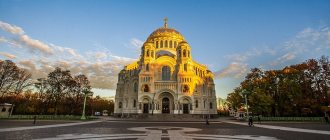I invite you to admire the most unusual and beautiful iconostases. First, a little history. The iconostasis is a partition that separates the altar from the rest of the room in an Orthodox church. In ancient times there were no iconostases; the altar was open or separated from the rest of the temple space by decorative columns. Gradually, a fence appeared so that in a crowded temple no stranger would enter the altar - the most sacred space of the temple.
Iconostasis of the Smolensk Cathedral of the Novodevichy Convent
Subsequently, especially revered icons began to be placed on the fence and on the shelf above it. Gradually the size of the partition and the number of icons began to increase. Iconostases received particular development in Rus', where most churches were wooden and did not have wall paintings, so increasing the number of icons became especially important. In Russian Orthodox churches, from about the middle of the Middle Ages, altar partitions became solid and completely hid the altar from the eyes of believers.
Seven-tiered iconostasis of the Great Cathedral of the Donskoy Monastery
Iconostasis of the Trinity-Sergius Lavra
It is believed that one of the first high iconostases was created at the very beginning of the 15th century for the Assumption Cathedral in Vladimir; it has not survived to this day. But we can see one of the first high iconostases and one of the three iconostases of the 15th century that have come down to us in the Trinity Cathedral of the Trinity-Sergius Lavra. The Trinity Cathedral of the Lavra is the oldest surviving building of the Lavra; it houses one of the greatest shrines of the Russian Orthodox Church - the relics of St. Sergius of Radonezh
Trinity Cathedral of the Trinity-Sergius Lavra
The value of the iconostasis of the Trinity Cathedral of the Trinity-Sergius Lavra is that it is the only complex from the early 15th century that has been preserved in the temple for which it was intended.
Iconostasis of the Trinity Cathedral of the Trinity-Sergius Lavra
This iconostasis was created in 1425-1427.
Deesis series.
The semantic center of this series is the icon of the Savior, represented, as a rule, in the image of a formidable Judge who appeared to judge the world. To the right and left of Jesus Christ are the Mother of God and John the Baptist. They are followed by archangels, saints, apostles, martyrs, saints, i.e. a host of saints, represented by all orders of holiness. The main theme of the Deesis rite is the church’s prayer for peace. Representatives of the earthly world who have achieved holiness and entered the Kingdom of Heaven, forming the Heavenly Church headed by Christ, prayerfully come before the throne of Christ the Judge, asking for leniency towards the earthly church gathered in the temple.
Iconostasis of Rublev
The icons and frescoes of the Trinity Cathedral were made by masters under the direction of the Rev. Andrei Rublev and Daniil Cherny. It was for this iconostasis that “Trinity” was painted - the great creation of Andrei Rublev and the most famous work of Russian icon painting in the world. Now the original is kept in the Tretyakov Gallery, and a copy is presented in the iconostasis
Iconostasis of the Trinity Cathedral of the Trinity-Sergius Lavra
Iconostasis of the Annunciation Cathedral
Also one of the very ancient is the iconostasis of the Annunciation Cathedral of the Moscow Kremlin - perhaps the most comfortable temple in the Kremlin, with a fabulous floor made of agate-like jasper in amber-honey shades
Annunciation Cathedral of the Moscow Kremlin
The iconostasis of the Annunciation Cathedral has not reached us in its original form as it was created. The icons of the 2nd and 3rd row from the bottom were painted at the end of the 14th – beginning of the 15th centuries (!). The rows above were written in the 16th century. In the center of the iconostasis are the silver, gilded, chased Royal Doors. It is interesting that in the lower row of the iconostasis there is a permanent place for the image of the heavenly patron of the reigning sovereign. After the death of the tsar, this icon was taken “to the grave”, and for the Annunciation Cathedral they painted a new image of the patron saint of the sovereign who ascended the throne
Iconostasis of the Annunciation Cathedral of the Moscow Kremlin
What is an icon in Christianity
To properly arrange a home iconostasis, you need to understand the meaning of the icon in Orthodoxy. “Icon” is translated from Greek as “image.” This is a sacred image of the Lord, the Mother of God, angels, saints or significant Christian events.
Icons are painted according to certain icon painting rules (canons), and then consecrated according to a special church rite. It includes reading prayers and sprinkling the image with holy water. If an icon is consecrated, it means that the Church has blessed its use in worship or home prayer.
Home iconostasis
The prototypes of icons are symbolic sacred images used at the dawn of Christianity. The first holy images familiar to us appeared, presumably, in the 4th century in Egypt. In the 8th century, a false religious doctrine (heresy) arose against the veneration of icons. The reason for this was the incorrect perception of the Old Testament commandment prohibiting the creation of idols - material idols for religious worship. The iconoclastic heresy was condemned by the Church at the Seventh Ecumenical Council in 787. Icon veneration became one of the tenets of Christianity and was finally established in the 9th century.
Construction of the iconostasis
Perhaps we should say something about the structure of the iconostasis. The images on the iconostasis are arranged in rows called tiers or ranks. Each rank has its own name, moving from bottom to top it is: local, deesis, festive, prophetic and forefathers. The tiers of the iconostasis must be read from top to bottom; they illustrate the course of history from ancient times to the present day (in the church interpretation). A five-tiered iconostasis is considered traditional in Orthodoxy, but rows with icons of the Passion of Christ, the Apostolic Passion, and some other compositions can be added. Here, for example, is the Church of the Intercession in Fili, a wonderful example of Naryshkin baroque
Church of the Intercession in Fili
In it, in the lower church, consecrated in honor of the Intercession of the Most Holy Theotokos, there is a three-tier iconostasis. It was created in the 19th century because the decorations on the first floor were looted and desecrated by the French in 1812. The Upper Church of the Savior Not Made by Hands has almost completely retained its original appearance and its main decoration - a stunning eight-tiered iconostasis of an unusual stepped shape.
Upper Church of the Savior Not Made by Hands, Church of the Intercession in Fili
The author of this carved miracle is one of the best masters of the Armory, Karp Ivanovich Zolotarev. The lush floral ornament seems to evoke images of a beautiful Garden of Eden in which the images of saints reside. See how carved decor changes the traditional outlines of icons, gives them unusual oval or multifaceted shapes, and moves them away from a clear division of tiers horizontally
But still, the main evolution of the iconostasis took place in the development of decor. Russian craftsmen were characterized by flat and blind, non-through carving. And the invited Belarusian and Ukrainian carvers worked in the so-called Flemish (i.e. Flemish) manner: incised, voluminous, almost sculptural carving made it possible to decorate interiors with unprecedented pomp and elegance
The left part of the iconostasis of the Church of the Savior Not Made by Hands, Church of the Intercession in Fili
Festive row.
The next tier of the iconostasis represents the New Testament period, namely the events associated with the earthly life of Christ. However, the holiday series is not a consistent illustration of the gospel story. Its content was determined by the context of the iconostasis as a single whole, as well as by various nuances of understanding the daily, weekly and annual cycles of worship. In the festive series, only those events are depicted that are significant stages of the Divine economy of salvation. Usually this series consists of icons of the Resurrection, the main twelve feasts (Christmas, Epiphany, Presentation, Entry into Jerusalem, Ascension, Transfiguration, Nativity of the Virgin Mary, Presentation into the Temple, Annunciation, Dormition), as well as two ecclesiological holidays of the moving cycle: Pentecost and Exaltation of the Cross .
Royal gates of the iconostasis
In the central part of the iconostasis are the Royal Doors. It is assumed that the iconostasis helps to understand the content and meaning of the worship taking place in the church; it is designed to clearly demonstrate that believers on their paths of spiritual life are not alone - they are helped by someone who has walked this path, achieved salvation and now prays with them. In the lowest row are the Royal Doors as an image of the doors to heaven. On the sides of the Royal Doors there are icons of the Savior and the Mother of God.
The central part of the iconostasis with the royal doors. Temple of the Savior Not Made by Hands, Church of the Intercession in Fili
The second icon to the right of the Royal Doors of the iconostasis is always an image depicting the saint (or event) in whose honor the temple was consecrated. That is, to find out what the name of the temple is and in whose honor it is consecrated, just look at the second icon to the right of the Royal Doors
The right side of the iconostasis. Temple of the Savior Not Made by Hands, Church of the Intercession in Fili
The meaning of the icon in Orthodoxy
Orthodox Christians pray and worship not the icon itself, but the person depicted on it. The sacred image serves only as a guide to the Prototype, with which the believer spiritually unites in prayer. Therefore, the images on Orthodox icons are characterized by simplicity and conventionality. They do not strive for high detail and naturalism. The Holy Venerable Paisius the Svyatogorets taught:
“When a Christian reverently kisses holy images and asks for help from Christ, from the Mother of God, from the saints, then he kisses with his heart, which absorbs not only the Grace of Christ, the Mother of God or the saints, but all of Christ or the Most Holy Theotokos or the saints , which stand in the iconostasis of his inner temple” (“Words”, volume 2).
The grace of the person depicted extends to the icon itself. The Holy Venerable John of Damascus in “Words against those who blame holy icons” noted that after the death of the righteous
“The grace of the Holy Spirit abides inexhaustibly in souls, and in bodies, and in their features, and in their holy images.”
Therefore, Orthodox Christians reverently perceive the icon as a shrine.
The icon also has theological significance and is one of the manifestations of church tradition. The veneration of holy images reflected the basic Christian dogmas. For example, the dogma of the Incarnation. After all, before the birth of Christ, any image of the invisible and indescribable God was prohibited. Painting His image would be a blasphemous fruit of human imagination. However, two thousand years ago the Lord became incarnate, that is, he took on human form. The Son of God became one of us, and with the help of icons we can testify to this. That is why icon veneration has become a separate dogma of Orthodoxy. Let us quote the words of Saint Theodore the Studite:
“Whoever does not worship the holy icon of the Lord does not worship the Lord Himself” (“Philokalia”).
Iconostases in Moscow
The capital of Russia accommodates more than 1000 churches and chapels, so one can only imagine the variety of iconostases hidden here! Before moving on to the description of particularly outstanding iconostases in Moscow, let me remind you that you can take a short tour of the churches of Moscow right now - if you visit the article Temples and Churches of Moscow.
A unique iconostasis has also been preserved in the Church of the Life-Giving Trinity in Ostankino. This church itself is very picturesque and elegant. Its lavish decor uses white stone carved details, colored glazed tiles, wide cornice belts, kokoshniks of various profiles, and bizarrely shaped platbands.
Church of the Life-Giving Trinity in Ostankino
Unfortunately, only the lower part with the royal doors has been preserved from the original iconostasis, which does not detract from its uniqueness. Firstly, the iconostasis of the church is 9-tiered. In an Orthodox publication I came across information that this iconostasis has 9 rows and 10 ranks and that there are only three such iconostases in Russia
Secondly, in the very bottom row, under the icons of the local rank, there are images of the “Hellenic sages” Orpheus, Istoikos, Thulidos and Apollo with “proclaiming” sayings about Christ on scrolls in their hands. These philosophers were never revered as saints, and the iconography of their images goes back to the Western tradition, according to which ancient philosophers were considered spontaneous Christians.
I was unable to photograph this lower row of the iconostasis because of twilight, and in photographs from the Internet, including from the temple website, this row is either not visible due to the openwork fence, or the images of the ancient sages are covered with special screens. In the next photo, taken from the church choir, the dark red screens with the image of a cross hide the faces of ancient philosophers
The iconostasis was created at the end of the 17th century - beginning of the 18th century (sources give slightly different dates). Its height is 13.5 m. Various techniques are used in it: silvering and gilding, which is very rare. Even in the same row, the icons have different shapes and differ in height and length. None of the tiers repeats the other. The two upper tiers of the late 17th century with 16 images of the Passion of Christ are the most complete of all the cycles on this topic in iconostases known so far. They are made largely from samples - obverse Bibles of Piscator and Weigel, as well as Rubens and Titian.
Iconostasis in the Church of the Life-Giving Trinity
The magnificent nine-tiered iconostasis was located in the Church of the Life-Giving Trinity in the village of Troitsky-Lykovo. The church was built in 1698-1703. presumably by the architect Ya. Bukhvostov. The snow-white, tremblingly beautiful church had a lush exterior decoration, and inside, up under the arches, to a height of 20 meters, a carved gilded iconostasis, made by the masters of the Armory Chamber and decorated in the Baroque style with vines and clusters, strange fruits and plants, went up.
Church of the Life-Giving Trinity in the village of Troitsky-Lykovo
Back in 1935, the Church of the Life-Giving Trinity was declared an architectural monument of world significance and registered by the League of Nations (later the UNESCO Commission), but this did not save it from destruction. By the beginning of the 21st century, the temple was in a deplorable state, and the iconostasis was practically lost. Now the temple has been completely restored, but no matter how I looked at the iconostasis, no matter how I counted, I only got 8 tiers. Perhaps some rank occupies an incomplete row and I cannot track it
But most of all in the iconostasis of the Trinity Church I was confused by the very bright gilding and the very smooth texture of the material from which the iconostasis is made, as if it were not wood or carving
To make it clear what we are talking about, here are a few photographs from the website of the workshop that restored the interiors of the temple (now the iconostasis looks the same).
Detail of the iconostasis of the Trinity Church in the village of Troitsky-Lykovo
I have not found any information anywhere about the material from which the restored iconostasis is made.
Detail of the iconostasis of the Trinity Church in the village of Troitsky-Lykovo
Here are the royal doors of the Church of the Life-Giving Trinity in Trinity-Lykovo
Iconostasis of the Intercession Cathedral
But in the main church of the Marfo-Mariinsky monastery - the Intercession Cathedral - the iconostasis is very simple. Despite the appearance of an ancient Russian temple, the cathedral was built by the architect A. Shchusev only a hundred years ago, in 1912, and is a magnificent example of the Art Nouveau style in temple architecture, playing on elements of Novgorod and Pskov churches of the 12th-14th centuries
Intercession Cathedral of the Marfo-Mariinsky Monastery
The interior paintings of the temple were done by the famous painter M.V. Nesterov. The interiors of the temple are very simple and the iconostasis is also laconically decorated.
In addition to the fact that it is single-tiered, the number of icons here is minimal: only two obligatory images, the Savior and the Mother of God
Iconostasis of the Church of Clement of the Pope
An excellent example of a Moscow iconostasis in the Baroque style is the iconostasis of the Church of Clement the Pope, which has been preserved almost in its original form. This Orthodox church was consecrated in honor of the holy martyr, belonging to the united Christian church, even before the division into Orthodoxy and Catholicism. Stone churches have been built on this site since 1657. The temple that has reached us was built in 1769, its architect is not known for certain. Most recently, at the end of 2013, the restoration of the temple was completed
Church of Clement Pope
The value of the interior of the Clement Church is in its stylistic integrity, in the thoughtful compositional and semantic unity of the iconostasis and the temple as a whole. You enter the temple through the low refectory and the baroque decoration of the side aisles begins to accompany you, which reaches its apogee when you find yourself in the central part of the temple. The architecture of the iconostasis is pointedly directed upward and your gaze rises to the dome and the light, where the top of the iconostasis goes into the drum of the main dome so that the golden rays of the top are level with the windows
Iconostasis of the central chapel of the Church of Clement of the Pope
The uniqueness of the iconostasis of the Church of Pope Clement is also in the fact that it covers all five chapels of the temple on two floors. In this photograph from the church choir, all five chapels are clearly visible - Preobrazhensky (central), Znamensky (lower left), Nativity of the Virgin Mary (upper left), Nikolsky (lower right), Voznesensky (upper right)
The grandiose golden wall of the iconostasis, similar to the façade of a building, has a complex, voluminous and broken configuration; it seems to step on us and then retreat, creating a movement of light and shadow, awakening emotions, not leaving us indifferent. The iconostasis is given special expressiveness by the three-dimensional figures of angels, which are located on three tiers of the central iconostasis. The height of the figures is more than one and a half meters
View from the choir to the central part of the iconostasis of the Church of Clement of the Pope
The painting of the iconostasis dates back to the 19th century and was made in a European manner, in the style of Italian art of the 18th century: free poses of figures, light-and-shadow solutions for space, flowing soft draperies and rich color. There are suggestions that some icons could have been painted by D.G. Levitsky. The picturesque compositions are enclosed in a variety of shaped frames: round, oval, elongated upward, inexpressibly complex, but always with gracefully curved outlines.
My theological knowledge is not enough to determine the ranks in this iconostasis, so I will rely on an article in a scientific collection, which says that the iconostasis includes three tiers and seven sub-tiers. The bottom row contains three scenes from the Acts of the Holy Apostles, the second - temple images and icons of saints; third – twelve feasts, gospel scenes and parables
The following photo of the iconostasis of the chapel of the Nativity of the Virgin Mary clearly shows the most skillful execution of the royal doors, which includes both masterly carving and painting
Iconostasis of the Cathedral of Christ the Savior
The iconostasis of the Cathedral of Christ the Savior was designed in a very original way. It was designed, like the entire cathedral, by the architect Konstantin Ton. The iconostasis of the Cathedral of Christ the Savior is an octagonal chapel, decorated in the Russian style with columns, keel-shaped kokoshniks, onion domes and crowned with a bronze gilded tent. The silhouette of the iconostasis resembles the silhouettes of the Kremlin towers and the Intercession Cathedral, personifying the national Russian style, images of Moscow and Russia.
The iconostasis of the Cathedral of Christ the Savior is four-tiered. Its height together with the tent is 26.6 meters - this is higher than a six-story building. Initially, the iconostasis was made of white, veinless, Carrara marble, with ornaments and inlays made of marble of different colors. Labradorite and Shoksha quartzite-sandstone were also used for finishing. The tent, domes with crosses, royal doors and frames for icons were gilded with yellowish or greenish gold.
During the restoration of the Cathedral of Christ the Savior, extensive research was carried out. For example, in the Museum of Geology named after. Vernadsky, authentic fragments of the iconostasis were found, which made it possible to clarify its design features and color scheme. In general, the iconostasis of the Cathedral of Christ the Savior has been recreated very close to its original appearance. White, even snow-white, polished marble gives the impression of being made of porcelain
Italian Carrara marble, domestic labradorite stones, red granite, porphyry and jasper were used
Iconostasis of the Church of Pimen the Great in Novye Vorotniki
At the end of the 19th and beginning of the 20th centuries, iconostases began to be created from new, previously unused materials. Here, for example, is the Church of Pimen the Great in Novye Vorotniki. The collars in the name of the settlement do not mean a piece of clothing, but the guards at the gates who settled in this area and gave it its name.
Church of Pimen the Great in Novye Vorotniki
The church itself is old: it was built in stone in 1702 on the site of a burnt wooden one, and then it was completed more than once. And in 1897, according to the design of the architect F. Shekhtel, the interiors of the temple were updated and an iconostasis was created, which has no analogues in Moscow. It is made of Italian marble and decorated with shallow but clearly legible carvings.
Since the church has a main altar (in honor of the Holy Trinity) and two side chapels (in honor of St. Pimen and the Vladimir Icon of the Mother of God), it is appropriate to have three iconostases. But here three separate iconostases are combined into a single three-part composition
Look at the photo from 1912: the iconostasis has remained virtually unchanged and has survived to this day as it was created by the great F. Shekhtel. Perhaps this was facilitated by the fact that the temple was not closed during Soviet times, although at one time it was a stronghold of renovationists - i.e. a movement that supported Soviet power and opposed the patriarch.
All three iconostases are two-tiered. In addition to the iconostasis, a lattice around the pre-altar space is made of marble. But the free-standing icon cases are made of wood and only painted to resemble marble. I saw the interiors of this church only under the dim lighting of candles and lamps, which creates sharp shadows that highlight the carvings. But look how luxurious carved marble looks in bright light
The royal doors are decorated with images of palm branches, and the entire iconostasis is decorated with grapevines with bunches of berries
I can’t help but say about the painting of the interior of the temple: this stylization of ancient Russian tower architecture was made with great artistic taste and imagination and gives you a feeling of fairy tale and magic. The paintings were made by students of the Stroganov School based on Shekhtel’s sketches. I found information that the temple’s ornaments were made according to the designs of M.A. Vrubel, and the plant patterns remind me of Bilibin’s drawings
View from the entrance to the interior of the Church of Pimen the Great in Novye Vorotniki
Iconostasis of the Church of the Transfiguration of the Lord in Tushino
An amazing echo of this Shekhtel iconostasis is the newly created iconostasis of the Church of the Transfiguration of the Lord in Tushino in our time. The current building of the temple was built at the end of the 19th century according to the design of the architect V.O. Grudzin. During Soviet times, the temple was closed, the bell tower and dome were blown up, and the premises were given over to warehouses.
Church of the Transfiguration of the Lord in Tushino
After the return, the temple was restored with a completely new, even innovative, interior decoration. According to the plan, the design of the temple should be such as to allow Orthodox Christians from any country in the world to find a piece of their culture here. As a result, the first part of the temple is painted with frescoes, and the walls and ceiling of the central part are decorated with mosaics made of natural stone with minimal inclusions of gold smalt. Dim, but clearly readable figures in the panels evoke images of ancient catacomb or cave temples.
The restrained design of the walls, devoid of open pathos and lush jubilation, is echoed by a single-tier iconostasis, in which analogies are read not only with the Art Nouveau era, but also with ancient Georgian and Greek temples
In 1994, five artists were awarded the State Prize of the Russian Federation for the mosaic decoration of the Church of the Transfiguration of the Lord in Tushino. Subsequently, one of the artists, Alexander Davydovich Kornoukhov, was invited to the Vatican to create mosaics in the chapel of the Papal Palace for the 2000 anniversary. This chapel, according to the plan of Pope John Paul II, was to become a symbol of the unity of Orthodox and Catholic culture
Porcelain iconostasis in the Church of the Transfiguration of the Lord
And in the Moscow region, in the city of Zheleznodorozhny, in this Church of the Transfiguration of the Lord, a unique porcelain iconostasis from the beginning of the last century has been preserved to this day. Churches have been built on this site since the 17th century. The current one was built at the end of the 19th - beginning of the 20th centuries according to the design of the architect A. Vetlitsky using voluntary donations from parishioners, and the merchant Vikula Morozov, the owner of a local manufactory, donated for the iconostasis
The three-tier iconostasis is made in delicate shades of white, pink and azure, with abundant gilding. I can’t believe that the iconostasis is over a hundred years old: the colors are very clean and shining, and the shine of the glazed surface and gold enhances the impression of elegance and solemnity. I especially liked the white dove above the royal doors, as if soaring from a dive after a steep fall, but I couldn’t photograph it separately
In addition to the central altar, two more were consecrated in the temple - in the name of St. Sergius of Radonezh and St. Seraphim of Sarov. In the side chapels dedicated to them, iconostases of the same type, but smaller, are installed. The height of the iconostasis is about 6 meters, the width of the central one is 12 meters, the side ones are 5 meters each.
One of the side chapels of the Church of the Transfiguration of the Lord in Zheleznodorozhny
The iconostasis consists of various and complex sculptural and geometric forms: columns with flutes, cornices of different profiles, bas-reliefs with floral patterns, medallions, three-dimensional ornaments. But all these elements were not just molded and sculpted, they were also fired at temperatures above a thousand degrees, which provided the iconostasis with such durability
An iconostasis was created at the Tver factory of the M.S. Kuznetsov partnership (now the Konakovo faience factory) according to the design of architecture professor V.A. Kosyakov and sculptor N.V. Annensky. In total, M.S. Kuznetsov’s factory produced 38 similar iconostases, which were installed in different cities of Russia. One iconostasis, exhibited at the World Exhibition in Paris in 1900, was purchased for the Russian Orthodox Church in the Czech city of Marianske Lazne.
It is interesting that porcelain, as a material for creating an iconostasis, was again turned to in the 21st century. Here, for example, is the Church of the Life-Giving Trinity in honor of the millennium of the Baptism of Rus' in Orekhovo-Borisov. This is a whole complex of the Patriarchal Metochion on Borisov Ponds, which includes a gate belfry, a chapel, a Sunday school and a clergy house
The entire complex is designed in Byzantine style. The Church of the Life-Giving Trinity was completed in 2004
The iconostasis was made by St. Petersburg workshops under the direction of the artist Yu. Volkotrub in the traditions of the already mentioned Kuznetsov workshops of the 19th century
I myself could not take photographs of the iconostasis, so I will show you what I managed to find on the Internet.
Gilding is widely used in the design. All icons for the iconostasis were painted again by a modern icon painter
Iconostasis of the Cross Chapel
But, perhaps, the greatest impression on me from modern interiors was made by the iconostasis and the entire decoration of the Krestovskaya Chapel. The chapel is located on the territory of the Church of the Sign, which, truly by the providence of the Lord, survived in the ring of the Riga overpass after numerous plans for demolition
Temple of the Icon of the Mother of God “The Sign” in Pereyaslavskaya Sloboda
First, just two words about the iconostasis of the Znamensky Church itself. It was made at the end of the 19th century specifically for this church, and it was never closed. The wooden, carved, gilded iconostasis has five tiers in the center and two tiers on the sides. The icons of the second tier are placed in round medallions decorated with flame-shaped kokoshniks. Some of the upper images are topped with three-bladed kokoshniks
Iconostasis of the Church of the Icon of the Mother of God “The Sign”
Now about the Krestovskaya Chapel. The original chapel was destroyed in Soviet times, but it was the cross stored in it that gave the name to the entire area - Krestovskaya Zastava, and then Krestovsky Bridge, Krestovsky Department Store. This cross was built in memory of the meeting of the relics of St. Philip, transferred to the Assumption Cathedral of the Kremlin from the Solovetsky Monastery. Now the cross is installed on the throne, lined with ledges with painted and relief ceramics. As if the background of the cross is some kind of icon case filled with figured ceramics with a floral pattern and gilding
Mirrored on the opposite wall, there is a ceramic icon case, with the same shape of the top and filling with figured ceramics as that of the cross. Also notice how beautiful the chapel floor is.
The cross and the icon are located on both sides of the iconostasis, the silhouette reminiscent of the iconostasis of the Cathedral of Christ the Savior
The design of the iconostasis, icon case and frame of the cross are made in the same style, with the same filling of the planes, ornaments, medallions and bas-reliefs
The meticulous, simply jewelry-like elaboration and execution of every detail is very impressive.
I never found who and where created this miracle. There is only information that the chapel was recreated with donations from Zenit Bank, Tatneft and the Sokolov family.
In the Krestovskaya Chapel, the modern icon of St. Nicholas the Wonderworker, made of semi-precious stones in the style of Florentine mosaic, also attracts attention.
The chapel is very small in area, but upward, towards the sky and light, it is directed to the entire height of two tiers and the dome
Inside view of the dome of the Cross Chapel
Helpful advice
The appearance of the iconostasis determines the perception of the temple decoration. Therefore, it is especially important that it matches the architecture of the temple. In ancient churches, iconostases are usually recreated in accordance with how they looked before destruction. However, not always. As is known, in the 18th – 19th centuries, church art was seriously influenced by secular art. Therefore, church rectors often decide to make the new iconostasis more consistent with the tradition of church piety: with large icons painted in the canonical style. In any case, if the temple is an architectural monument, when recreating its decoration you should be very careful so as not to conflict with current legislation.
From the history
The first altar barriers known to us appeared in the 4th century AD. They were a low parapet, a lattice. Something similar happened in ancient public institutions, where the places of judges and clerks were separated by bars from the premises for visitors. Over time, icons began to be installed on this parapet in the temple. It became taller and more decorative.
The appearance of the iconostasis, hiding what is happening in the altar from the laity, is associated with the name of St. Basil the Great. The life of the saint says: “ Saint Basil the Great also had such a gift of grace. When he offered up the Holy Gifts during the Liturgy, the golden dove with the Divine Gifts, hanging over the holy throne, moved by the power of God, shook three times. Once, when Vasily served and offered up the Holy Gifts, the usual sign with a dove, which with its shaking indicated the descent of the Holy Spirit, was not there. When Vasily thought about the reason for this, he saw that one of the deacons holding the ripids was looking at the woman standing in the church. Basil ordered that deacon to retreat from the holy altar and assigned him penance <…>. From that time on, Saint Basil ordered that a curtain and a partition be erected in the church in front of the altar <...>
"(St. Demetrius of Rostov. Lives of the Saints, vol. 1).
From this quote it follows that, at the direction of St. Basil, a curtain appeared on the iconostasis - katapetasma
. We still see it today above the Royal Doors.
Over the centuries, a scheme for placing the main images in the iconostasis, common to different countries, was formed. The number of rows increased. The decor became more complicated. By the 17th century, five-tiered iconostases had become widespread in Russia.
After Peter's reforms, when the Church in Russia was actually subordinated to the state, temple architecture in most cases began to follow the wake of the styles fashionable in secular architecture at that time. Iconostases appeared, made in the style of Baroque, then classicism, gothic, and modern. Nowadays, iconostases are created in a variety of styles, starting with Byzantine.
